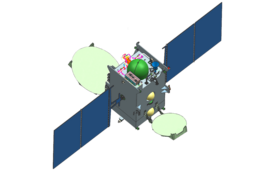GSAT-9
| GSAT-9 | |
|---|---|

|
|
| Start date | May 5, 2017, 11:27 UTC |
| Launcher | GSLV MkII F09 |
| Launch site | Satish Dhawan Space Center |
| COSPAR-ID : | 2017-024A |
| Takeoff mass | 2230 kg |
| Empty mass | 976 kg |
| Dimensions | 1.53 x 1.65 x 2.40 m |
| Manufacturer | ISRO |
| Satellite bus | I-2K |
| lifespan | 12 years |
| Stabilization | Three-axis stabilization |
| operator | ISRO |
| Playback information | |
| Transponder | 12 Ku-band transponders |
| Others | |
| Electrical power | 3.5 kW |
| Power storage | two 90 Ah lithium-ion batteries |
| position | |
| First position | 48 ° East |
| drive | one 440-N, eight 10-N and eight 22-N engines, four plasma engines |
| List of geostationary satellites | |
GSAT-9 (also South Asia Satellite ) is a commercial communications satellite of the Indian GSAT .
He was born on May 5, 2017 at 11:27 UTC with a GSLV - carrier rocket from the rocket launch site Satish Dhawan Space Center in a geostationary brought orbit.
The three-axis stabilized satellite with 12 Ku-band - transponders equipped, a m- 1.4 and a 2.0-by-2.2-m-reflector antenna and to provide the position of 48 degrees East South Asia, with telecommunications services. GSAT-9 was designed for shared use by all members of the South Asian community SAARC , which includes India and Pakistan . India has offered almost all of its neighboring countries to use part of the transmission capacities free of charge. All members except Pakistan want to accept the offer. The satellite was built on the basis of the I-2K satellite bus from ISRO and has a planned service life of 12 years. The two solar cell arms are built with ultra triple junction solar cells and deliver around 3500 watts. Sun and earth sensors as well as gyroscopes are used to align the satellite. The position control is carried out with the help of impulse wheels , magnetic torques and eight 10-N and eight 22-N engines. The propulsion system of the satellite consists of a 440 N Apogee motor (specific impulse 3.041 Ns / kg) and engines with liquid fuels for attitude and orbit control. The satellite also carries four plasma engines with 18 mN thrust each, which support orbit control. The chemical engines use UDMH as fuel and MON3 as oxidizer, the electric xenon as support mass (80 kg supply). GSAT-9 carries a GAGAN system in addition to the communication payload .
Web links
- ISRO: manufacturer website
Individual evidence
- ↑ a b c d e f g ISRO: GSLV-F09 GSAT-9 , accessed on July 1, 2017.
- ↑ a b Spaceflight 101: GSAT-9 - GSLV - GSAT-9 | Spaceflight101 , accessed July 1, 2017.
- ↑ a b NASASpaceFlight.com: India's GLSV rocket successfully launches GSAT-9 | NASASpaceFlight.com , accessed July 1, 2017.
- ↑ heise online: Diplomacy in space: India launches "South Asia satellite" , accessed on July 1, 2017.